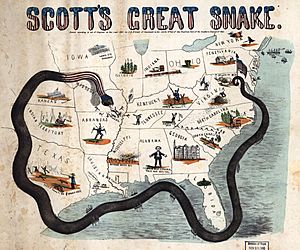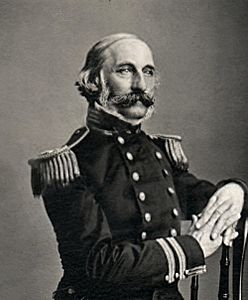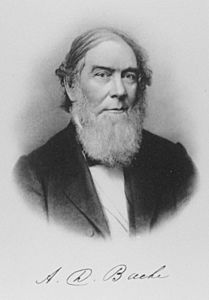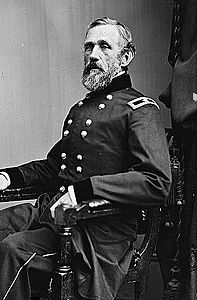Blockade Strategy Board facts for kids
The Blockade Strategy Board was a special group created by the United States Navy Department at the start of the American Civil War. Its main job was to plan how to enforce President Abraham Lincoln's order to block off Southern ports. This order, called the Proclamation of Blockade Against Southern Ports, aimed to stop ships from entering or leaving the Confederate coastline. This was a huge task, as it involved watching over 3,500 miles (about 5,600 km) of Atlantic and Gulf coastline, including 12 important ports like New Orleans and Mobile. The board met in June 1861. Its members were Samuel Francis Du Pont (who led the group), Charles Henry Davis, John Gross Barnard, and Alexander Dallas Bache. They worked together to figure out the best way to cut off sea travel to and from these Southern ports. Their plans for the Atlantic coast were mostly used to guide the early naval war. However, their ideas for the Gulf Coast were not as successful. This was mainly because they didn't have as much detailed information about the Gulf's waters as they did for the Atlantic.
Contents
Why Was the Board Created?
The Start of the Civil War
The Civil War began when Fort Sumter in Charleston Harbor was attacked and taken by Confederate forces in April 1861. Soon after, on April 19, President Lincoln announced a blockade of all ports in the states that had left the Union. These states included South Carolina, Georgia, Florida, Alabama, Mississippi, Louisiana, and Texas. Later, when Virginia and North Carolina also joined the Confederacy, their ports were added to the blockade.
This blockade, which was just an idea at first, became a key part of General Winfield Scott's plan to bring the Southern states back into the Union. His plan was called the Anaconda Plan. Even though it was never officially adopted as the main war strategy, the U.S. Navy worked hard to enforce the blockade throughout the entire war.
At the beginning of the war, the Union Navy was not ready to carry out such a large blockade. It had only 90 ships in total, and only 42 of them were powered by steam. To fix this, the Navy quickly started building new ships and converting merchant ships into warships. By the end of the war, the number of ships grew to 671. However, as these new ships became ready, the Navy had to decide which tasks were most important.
The person in Lincoln's cabinet who pushed for a well-organized blockade was Secretary of the Treasury Salmon P. Chase. His department, the Revenue Cutter Service, knew a lot about the nation's ports. Also, the Coast Survey, which was part of his department, had detailed maps of harbor bottoms. This information would be very useful for naval commanders patrolling those waters.
Chase convinced Secretary of the Navy Gideon Welles to create a group to study the entire Southern coast. So, on June 25, 1861, Welles gave the order to Captain (who later became Rear Admiral) Samuel Francis Du Pont to lead this group. He also assigned Commander (later Rear Admiral) Charles Henry Davis to be the group's secretary. Additionally, he asked Army Major (later Major General) John G. Barnard, who was in charge of the Army Corps of Engineers, and Alexander D. Bache, the Superintendent of the Coast Survey, to join. While others offered advice, only these four men signed all the reports issued by the commission.
What Did the Board Recommend?
The Blockade Strategy Board wrote seven reports for the Navy Department between July 5 and September 19, 1861. These reports are now part of the official records of the Civil War. Here are some of their key recommendations:
- July 5, 1861: They suggested taking Fernandina, Florida, and its harbor. They saw it as an important point to anchor the southern end of the Atlantic blockade line.
- July 13, 1861: They looked at the South Carolina coast, especially Bull's Bay, St. Helena Sound, and Port Royal Sound. They recommended capturing and holding at least one of these locations.
- July 16, 1861: They advised dividing the Atlantic Blockading Squadron into two parts, with the split happening at Cape Romain in South Carolina. They also suggested ways to complete the blockade between Cape Henry and Cape Romain.
- July 26, 1861: This report covered other parts of the Atlantic blockade not included in the earlier July reports.
- August 9, 1861: They divided the Gulf Coast into six areas. Their main recommendations focused on New Orleans and Mobile. They suggested capturing Ship Island to use as a base for operations against either city.
- September 3, 1861: This report dealt with parts of the Gulf Coast not covered in the August 9 report.
- September 19, 1861: They looked at Ship Island and the lower Mississippi River in more detail than in the August 9 report.
How Did the Board's Plans Affect the War?
Atlantic Blockade Impact
The Lincoln administration mostly accepted the board's recommendations for the Atlantic blockade, though with some changes. For example, the capture of Fernandina, which the board suggested as the first naval attack, was delayed. It happened after Hatteras Island and Port Royal were captured instead. The board's idea to block Hatteras Inlet was also changed by Flag Officer Silas Stringham and Brig. General Benjamin F. Butler, who led the expedition there. The board had actually expected that their plans might not be followed exactly. They even wrote in their report that "These plans may undergo some modification in the hands of the person to whom their execution shall be intrusted."
The capture of Port Royal Sound was another change from the board's original plan. They had preferred an attack on St. Helena Sound, which was closer to Charleston and would have been harder for the Confederates to defend. However, Port Royal had such great natural advantages that the administration chose to take it instead. Interestingly, Captain (who was by then Flag Officer) Du Pont, the board's chairman, was chosen to lead the naval part of the attack on Port Royal.
Gulf Blockade Challenges
The Gulf blockade plans changed much more from the board's original ideas. One big reason was that there was less detailed knowledge about the Gulf Coast compared to the Atlantic. The maps and information about the water depths and currents were not as good. Because of this, one of the board's strongest recommendations was to assign a Coast Survey ship to each blockading squadron. This idea was accepted, and the Coast Survey proved to be very helpful throughout the war.
Even though Ship Island was captured as the board suggested, the Navy Department used it as a base for David G. Farragut's attack and capture of New Orleans. The board had actually been against any immediate move up the Mississippi River. Not because it was a bad idea, but because they believed it couldn't be done with the weapons and ships available at that time.
The blockade of the southern part of the Texas coast also didn't go as the board expected. The problem there was that the port at Brownsville, near the mouth of the Rio Grande, also served the Mexican town of Matamoros. This created international issues for the blockade, especially since there was a rebellion happening in Mexico against Emperor Maximilian at the time.
Lasting Importance
Even though it might seem that the Blockade Strategy Board had only a small impact on the war, it was still very important. It was the first time the United States tried to plan a war using logical principles, rather than just reacting to events. At that time, the armed forces didn't have a special office for naval operations or a general staff to plan strategies. So, the board acted as a basic version of these modern planning groups. Because of this, it was an important step towards how military planning is done today.






